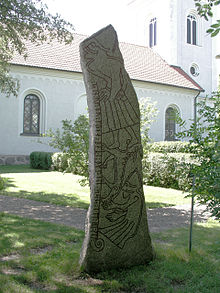Ledberg stone
| Ledberg stone | |
|---|---|
 | |
| Created | 11th Century |
| Discovered | Ledberg, Östergötland, Sweden |
| Rundata ID | Ög 181 |
| Text – Native | |
| See article. | |
| Translation | |
| See article. | |
The Ledberg stone, designated as Ög 181 under Rundata, is an image-stone and runestone located in Östergötland, Sweden.
Description

The Ledberg stone is a partially surviving runestone, similar to Thorwald's Cross. It features a figure with his foot at the mouth of a four-legged beast, below which lies a legless, helmeted man, with his arms in a prostrate position.[1] This is thought to be a depiction of Odin being devoured by the wolf Fenrir at Ragnarök, the final battle in Norse mythology, in which several gods meet their death.[1] The battle and death of Odin are described in the poem Völuspá from the Poetic Edda.[2]
Some scholars, however, believe that the images of the Ledberg stone depict the final story of either Þorgautr or Gunna,[citation needed] who are memorialized in the runic inscription. If the images are followed in the same order as the runes are written, they seem to create a chronological account. The first image is of a ship; this depicts a journey abroad. Next, there is a figure walking to the left, carrying what is most likely a shield, in preparation for departure. In the third image, the figure is carrying weapons and a shield to the right, probably marching to battle. At the top of the second side of the stone, the figure's foot is being bitten by a wolf and finally, we see the figure legless with arms sprawled, likely lying dead on the battlefield. Wolves were often used in Viking art and poetry to signify combat,[3] so it is thought to be unlikely that the figure fell in battle due to wounds caused by a wolf.
The warrior figures have shields, one carries a spear, and all have moustaches and beards, except for the Odin figure. The helmets are conical and similar in shape to those shown on the Bayeux Tapestry.[4]
Inscription

The runic inscription of the Ledberg stone is carved in the Younger futhark, and is dated to the 11th century. It reads:[5]
ᛒᛁᛋᛁ
(b)isi
᛬
·
ᛋᛅᛏᛁ
sati
᛬
:
ᛋᛏᛁ
sti[n]
᛬
:
ᚦᛁᛋᛁ
þisi
᛬
:
ᛁᚠᛏᛁᛦ
iftiʀ
᛬
:
ᚦᚢᚱᚴᚢᛏ
þurkut
᛬
:
ᚢ----ᚦᛁ
u----þi
᛬
:
ᚠᛅᚦᚢᚱ
faþur
ᛒᛁᛋᛁ ᛬ ᛋᛅᛏᛁ ᛬ ᛋᛏᛁ ᛬ ᚦᛁᛋᛁ ᛬ ᛁᚠᛏᛁᛦ ᛬ ᚦᚢᚱᚴᚢᛏ ᛬ ᚢ----ᚦᛁ ᛬ ᚠᛅᚦᚢᚱ
(b)isi · sati : sti[n] : þisi : iftiʀ : þurkut : u----þi : faþur
Bisi placed this stone in memory of Þorgautr … his father.
᛬
:
ᛋᛁᚾ
sin
᛬
:
ᚢᚴ
uk
᛬
:
ᚦᚢ
þu
᛬
:
ᚴᚢᚾᛅ
kuna
᛬
:
ᛒᛅᚦᛁ
baþi
᛬
:
᛬ ᛋᛁᚾ ᛬ ᚢᚴ ᛬ ᚦᚢ ᛬ ᚴᚢᚾᛅ ᛬ ᛒᛅᚦᛁ ᛬
: sin : uk : þu : kuna : baþi :
And Gunna, both.
Charm
The final part of the B-side contains a rhyming charm or spell (galdr), which reads:
ᚦᛘᚴ
þmk
᛬
:
ᛁᛁᛁ
iii
᛬
:
ᛋᛋᛋ
sss
᛬
:
ᛏᛏᛏ
ttt
᛬
:
ᛁᛁᛁ
iii
᛬
:
ᛚᛚᛚ
lll
᛬
:
ᚦᛘᚴ ᛬ ᛁᛁᛁ ᛬ ᛋᛋᛋ ᛬ ᛏᛏᛏ ᛬ ᛁᛁᛁ ᛬ ᛚᛚᛚ ᛬
þmk : iii : sss : ttt : iii : lll :
which is to be read (in normalized Old Icelandic spelling):
þistill,
mistill,
kistill
casket
þistill, mistill, kistill
This type of charm (istill formula) is found on a few other inscriptions, among them the runic inscription on the Gørlev runestone, DR 239, from Sjælland, Denmark.[6] It has been noted that Pliny the Elder recorded that the Celts gathered mistletoe as a cure for infertility, and that singing a charm over herbs increased their power, which may have led to the þistill mistill kistill combination.[6]
Of the personal names in the inscription, Þorgautr contains as a name element the Norse god Thor.
See also
References
- ^ a b Jansson, Sven B. (1987). Runes in Sweden. Stockholm, Gidlund. ISBN 91-7844-067-X. p. 152.
- ^ Bellows, Henry Adams (trans.) (1936). Völuspá, stanzas 51-59.
- ^ See Jesch, Judith (2002). "Eagles, Ravens and Wolves: Beasts of Battle, Symbols of Victory and Death". The Scandinavians from the Vendel Period to the Tenth Century: an Ethnographic Prospective. Boydell Press. pp. 251–270. ISBN 0-85115-867-6.; and Gräslund, Anne-Sofie (2006). "Wolves, Serpents and Birds: Their Symbolic Meaning in Old Norse Belief". In Andrén, Anders; Jennbert, Kristina; et al. (eds.). Old Norse Religion in Long-Term Perspectives: Origins, Changes, and Interactions. Lund: Nordic Academic Press. pp. 124–129. ISBN 91-89116-81-X.
- ^ Lewis, Michael (2005). "The Bayeux Tapestry and Eleventh Century Material Culture". In Owen-Crocker, Gale R. (ed.). King Harold II and the Bayeux Tapestry. Boydell Press. pp. 181–182. ISBN 1-84383-124-4.
- ^ "Runic inscription Ög", Scandinavian Runic-text Database, Department of Scandinavian Languages, Uppsala University, 2020, retrieved December 11, 2021
- ^ a b c MacLeod, Mindy; Mees, Bernard (2006). Runic Amulets and Magic Objects. Boydell Press. pp. 145–148. ISBN 1-84383-205-4.
- v
- t
- e
Old Norse religion
- List of runestones
- Rundata
- Runic inscriptions online interactive map

58°26′32″N 15°26′50″E / 58.44222°N 15.44722°E / 58.44222; 15.44722











